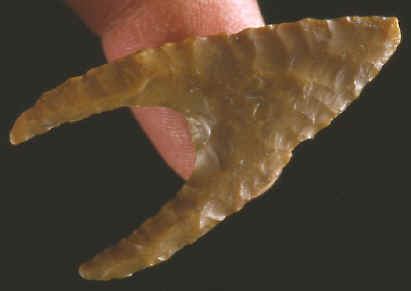|
HOLLOW
BASE
POINT by Michael Allen Hoffman Ph.D
Hollow Base projectile points are roughly willow leaf shaped with a deep
area hollowed out of their bases. They are generally finely pressure
flaked on both faces and display thin biconvex cross-sections. The
variation in size and weight suggests that most once tipped darts that
were hurled with a throwing stick or atlatl, although, a few of the
smaller specimens may have been actual arrowheads. -------------------- Hollow Base points have deeper concave bases than any other projectile point in the world. One or more of their fragile "ears" are usually found broken off. Complete examples are fairly rare. It seems as I f they were designed to break on impact. Either that is the explanation or they were just poorly designed. Which is hard to believe since they were made and in use for approximately 2,000 years! Hollow Base points were hafted onto the ends of spear shafts by sliding the point into grooves cut on either side of the shaft. Hafted examples still exist in the museum at Cairo, Egypt. The Hollow Base point in this picture is made of an opaque yellow- orange chert and measures 1 7/8 inches long. |
